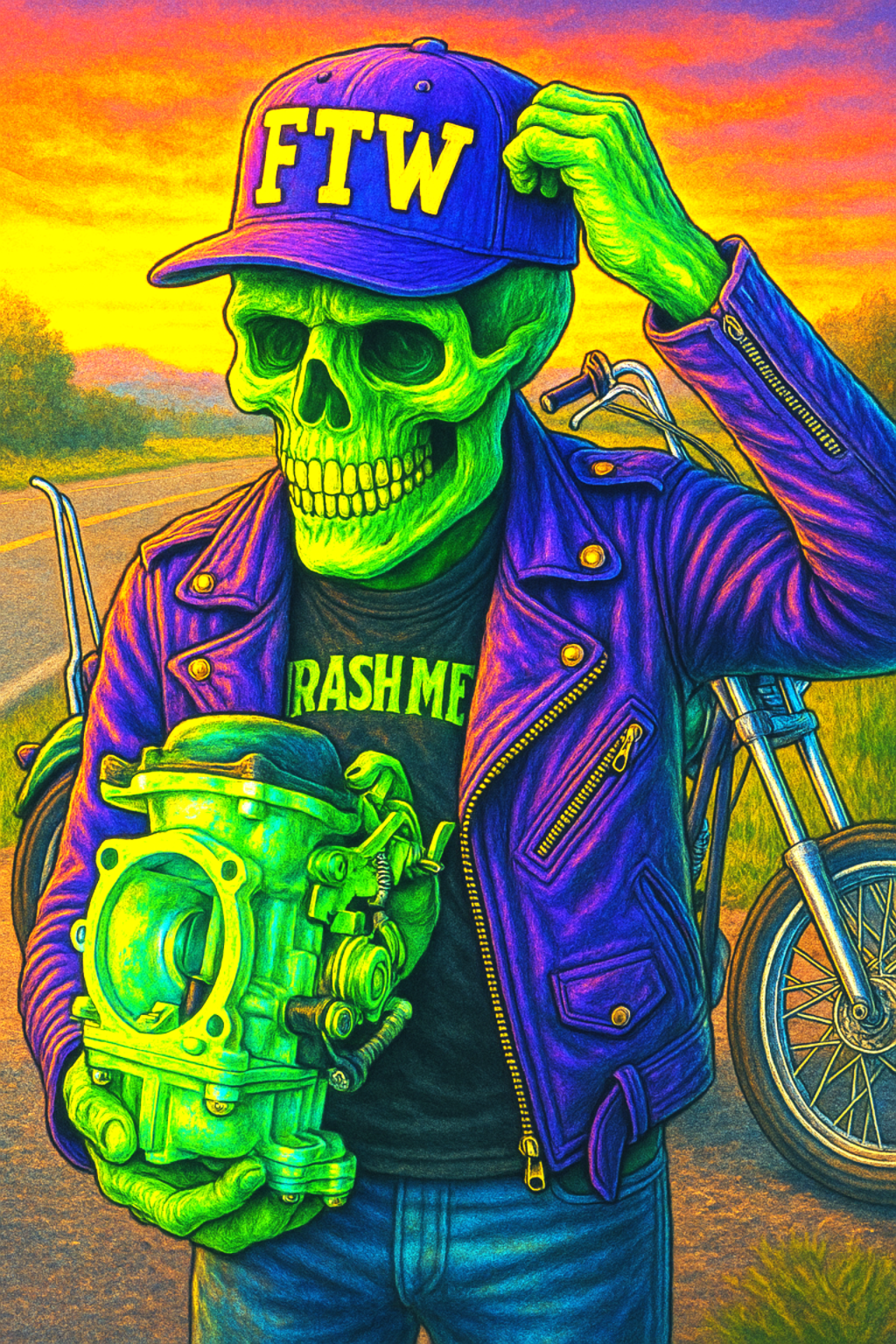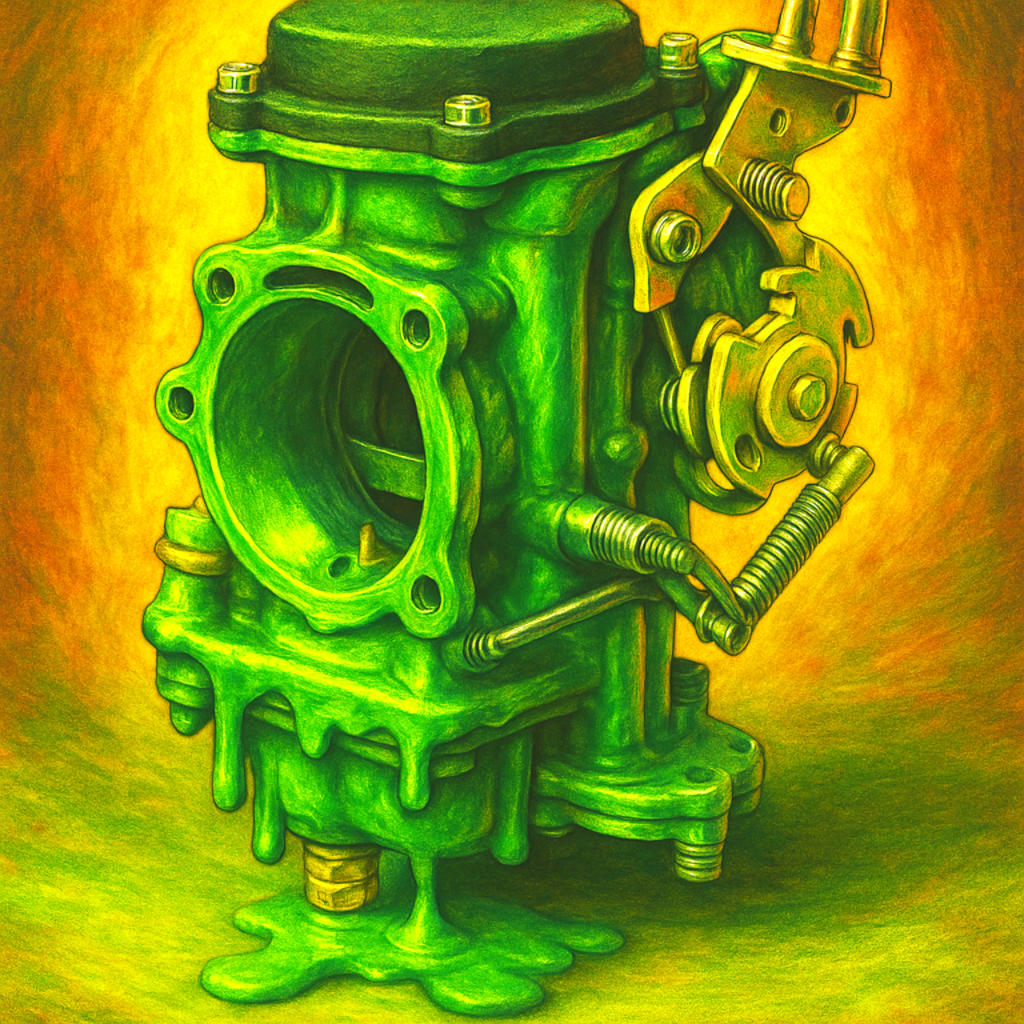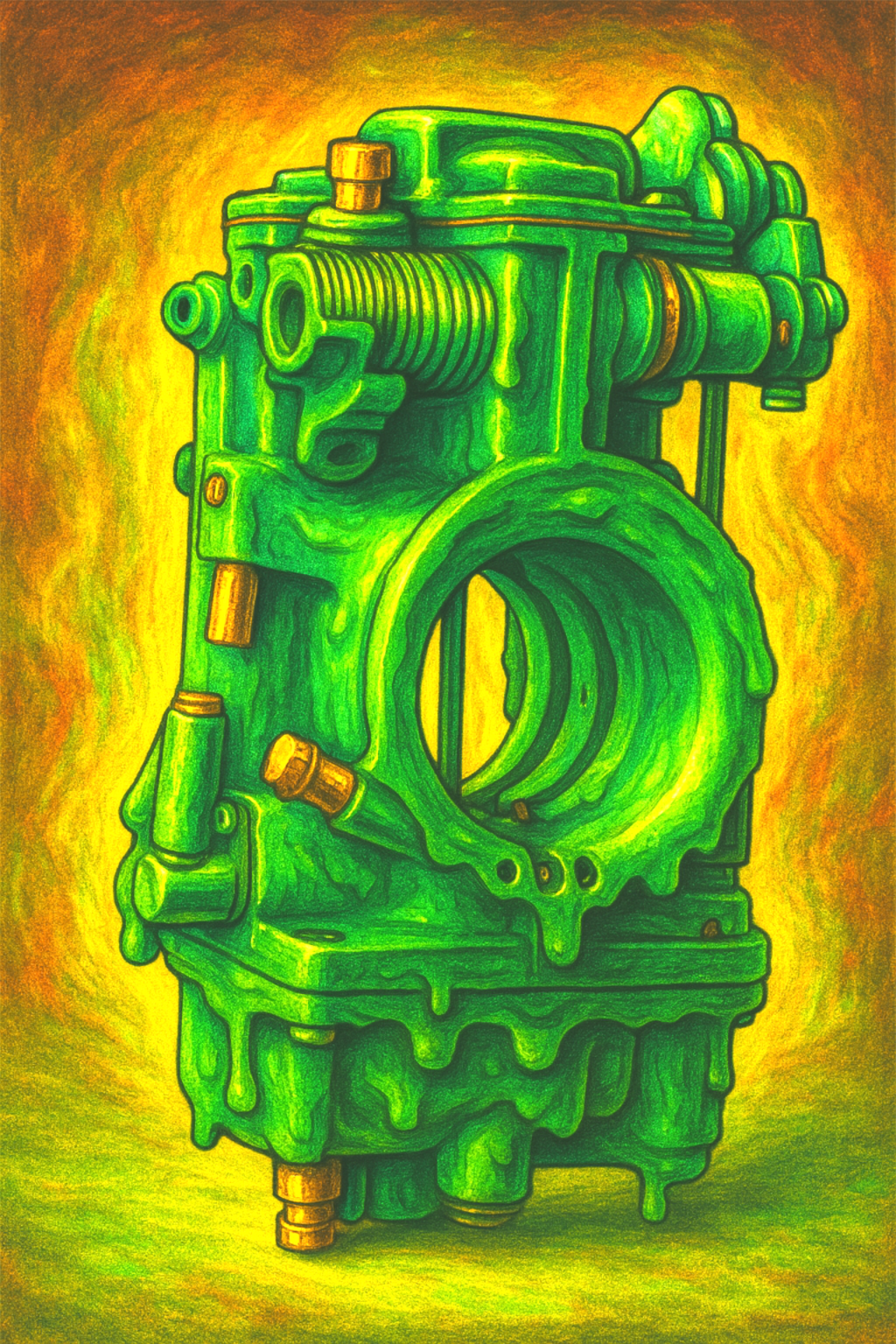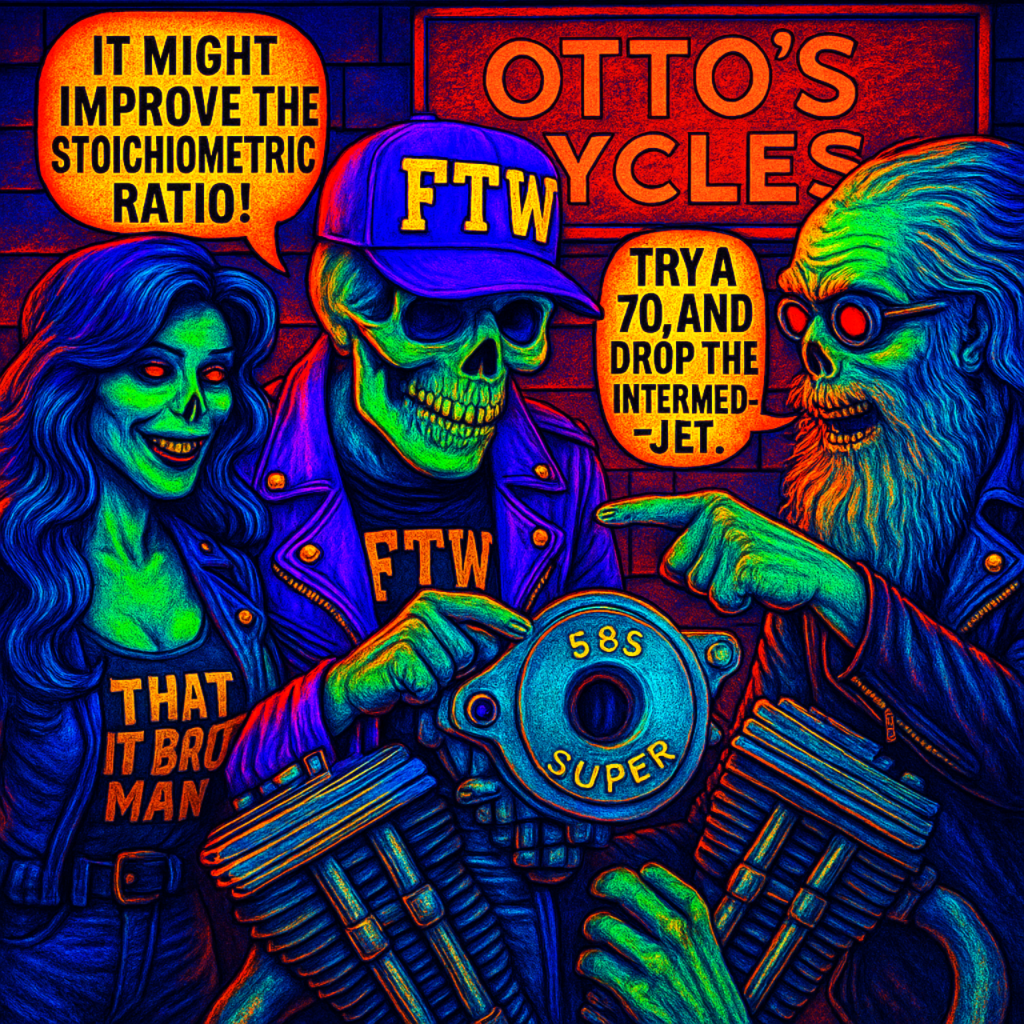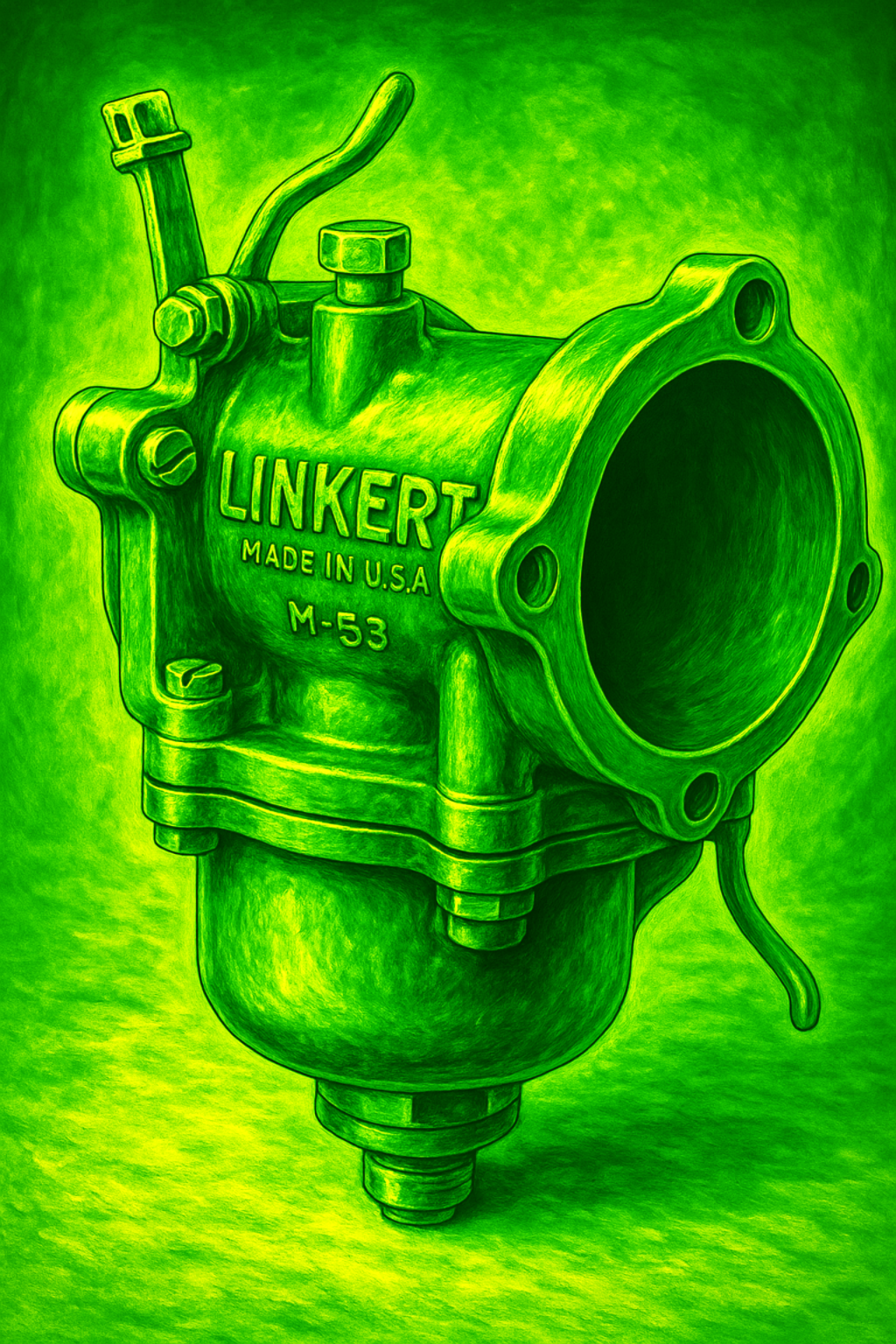The Carb Code
“He may be bones and brains, but he’s about to dial that idle screw like a damn wizard.”
**THE CARB CODE**
Understand, Tune, and Troubleshoot CV, Mikuni, and S\&S for Harley Riders
In a time when laptops talk to engines and check engine lights double as tarot cards, carburetors can seem like relics from a forgotten era. But if you’re riding an Evo, wrenching a chopper, or just trying to make your Harley feel alive under throttle, you already know the truth: carbs still matter. They’re the mechanical soul of your machine. No sensors, no software, no black box guesswork. Just throttle, air, and fuel—with you in control.
Fuel injection might be the standard now, but it’s not always the best choice—especially on early EFI Harleys like those using the Magneti Marelli system. These systems are notoriously finicky, hard to tune without factory tools, and getting replacement parts is becoming a scavenger hunt. That’s why more and more riders are ripping them off in favor of simple, reliable carbs.
Swapping to a carb setup can eliminate complicated sensors and unreliable ECMs. It makes roadside tuning possible and reduces the cost and hassle of sourcing obsolete EFI parts. More importantly, it gives you full mechanical control of your fuel delivery.
It’s also a common mod for late-model Evo Sportsters, especially the 2004–2006 range that came EFI but are otherwise great platforms for customization. Going back to a carb gives these bikes a throwback feel, makes tuning easier, and fits perfectly with the stripped-down chopper or bobber aesthetic.
Whether you’re bringing life back to a vintage Shovel, building a stripped-down chopper, or just trying to get your Evo to idle right, carbs give you control. Real control. The kind that doesn’t need a laptop or a Bluetooth dongle—just a screwdriver, a jet kit, and a little know-how.
**WHAT THE HELL IS A CARBURETOR?**
A carburetor—or just “carb”—is a mechanical fuel mixer. It pulls air through a venturi, a narrowing tunnel that increases airspeed. That fast-moving air draws fuel out of small brass jets and atomizes it into the stream. That air-fuel mix flows into your motor. More throttle means more air, more air means more fuel, and more fuel means more power. No sensors, no software, no electronics. Just airflow, pressure, and fuel metering done by brass and physics.
Think of it like a spray bottle. The harder you squeeze the throttle, the more air you pull in, and the more fuel gets sucked up through the jets. Inside, different fuel circuits handle different throttle positions—there’s an idle circuit, a pilot circuit, a needle jet for midrange, and a main jet for wide-open throttle. It’s a balancing act, and once you understand it, tuning becomes second nature.
**CHAPTER 1: THE CARBS THAT CAME BEFORE**
Before the CV, Mikuni, or S\&S ever hit a Harley manifold, there was a long line of gritty, stubborn, and sometimes downright wild carburetors. Each one came from a specific era and gave Harleys their sound, feel, and attitude.
The Linkert was the brass legend found on Flatheads, Knuckles, and early Pans. They’re iconic, tunable, and temperamental. If you’ve ever kicked a Knuckle more than five times, odds are you’ve been humbled by a Linkert.
In the mid-1960s, Harley experimented with Tillotson diaphragm carbs. They had internal pumps and no float bowls. Great in theory, but tuning them was pure voodoo—sensitive to altitude, humidity, and the phase of the moon.
Bendix carbs came next. Simple, reliable, and easy to work on, they were a favorite for Shovel riders in the early ’70s. But they weren’t refined. No vacuum smoothing. Just raw throttle and fuel.
Keihin butterfly carbs showed up in the mid-to-late ’70s, offering a step forward in street manners. Soon after, the Constant Velocity (CV) version of the Keihin appeared on Harleys in the ’80s and became the stock carb on Evos and early Twin Cams. Around this time, Zenith also supplied similar units on select models.
**CHAPTER 1: THE CV CARB**
The Constant Velocity (CV) carb is the unsung hero of the Harley world. Found on most Evo engines and early Twin Cams, it came stock on countless bikes and still delivers dependable performance with just a few tweaks. It’s smooth, forgiving, and cheap—but it’s not built for speed demons or throttle junkies.
Constant Velocity (CV)
The CV’s roots trace back to emissions-era technology. Harley needed a smoother carb that met EPA regulations while still being tunable for real-world riders. The Keihin CV40 became the answer—balancing fuel economy, emissions control, and daily rideability.
The CV works by using vacuum to lift a slide, which controls the needle and fuel delivery. This vacuum-based operation smooths out throttle transitions and avoids bogging under sudden twist. Because of that, it's the favorite of daily riders and people who just want their bike to start and run.
Inside, it’s simple: a diaphragm-mounted slide, a tapered needle, pilot and main jets, and an idle mixture screw. Most riders start tuning with a 45 pilot and 180 main jet for 1200cc bikes, shimming the needle slightly for midrange fuel. Want better throttle response? Drill out the vacuum port a touch and install a lighter spring or adjust slide lift hole diameter—but don’t overdo it.
The CV’s standard intake manifold fits stock Harley heads and CV flanges. Make sure the flange isn’t cracked and the rubber seal is in place.
**CHAPTER 2: THE MIKUNI HSR**
If the CV is the laid-back veteran who always gets the job done, the Mikuni HSR is the young gun—fast, aggressive, and ready to respond the second you twist the throttle.
Mikuni HSR-42
Mikuni developed the HSR as a performance alternative for riders frustrated by the limitations of vacuum carbs. Inspired by racing tech, they built the HSR42, HSR45, and HSR48 to be responsive, tunable, and efficient under throttle.
These are flat-slide, cable-operated carbs. They don’t use vacuum to lift a slide—they’re mechanical. That makes them snappy. When you roll on the throttle, the slide lifts instantly, delivering air and fuel without delay. It’s why Mikunis are a favorite for performance builds.
These carbs also have an accelerator pump—a little piston that squirts fuel when you twist the throttle quickly. The shot is tunable, but if you get it wrong, you’ll flood the intake or get a nasty off-idle bog. Getting that pump timing just right is a fine art.
Typical jetting starts around a 25 pilot, 160 main, and a 97 needle on the third clip. Mikunis respond beautifully to high-flow intakes, free-breathing pipes, and big-inch motors with cams.
Mikuni HSR carbs require a specific intake manifold. For HSR42 and HSR45, Mikuni offers adapter flanges to fit most Harley manifolds or a dedicated HSR manifold if needed.
**CHAPTER 3: THE S\&S SUPER E/G**
If the CV is smooth and the Mikuni is sharp, then the S\&S Super E and G are raw, mechanical, and unapologetically American.
S&S Super E “shorty” Carb. ‘Cause it’s short.
Born from the chopper boom and performance street builds of the 1970s, the S\&S Super series was built for riders who wanted simplicity, reliability, and torque. The Super B came first, but the Super E refined that design and made it street-friendly.
The Super E has a 1-7/8” bore and the G jumps to 2-1/16”. They use a simple butterfly valve, with no vacuum assistance—just throttle in, fuel out. You control everything. They’re built for torque and reliability, not smoothness.
This is the go-to carb for kickstart choppers and custom builds, and for good reason—it’s dead simple. No vacuum circuits, no extra tuning steps, and no waiting for slides to rise. Just a mechanical throttle plate that responds the second you kick it through.
For riders running magneto ignition, minimal wiring, or no battery at all, the Super E or G is a no-brainer. It’s also the easiest to field-strip and jet. Intermediate jets handle idle and cruise; the main jet handles wide-open throttle. There’s no needle. Just brass and bite.
The S\&S Super carbs mount to an S\&S-specific manifold, which must be matched to your cylinder head type (Shovelhead, Evo, or TC). Make sure the manifold o-rings or gaskets are sealing tight.
**CHAPTER 4: TUNING MADE SIMPLE**
The tuning process follows the same roadmap across all three carbs. You start with idle and cruise, then work through midrange and wide-open throttle. You don’t guess—you read the bike.
Always check for vacuum leaks before you start jetting. Carb support brackets, intake seals, and manifold gaskets all need to be tight. If the idle is erratic or hanging, you may be chasing a leak, not a jet issue.
With a CV, tuning starts with the idle mixture screw. Turn it in until it gently seats, then back it out 2 to 2.5 turns. From there, you fine-tune by ear or feel. Mikunis and S\&S follow similar logic but respond more quickly.
Once your pilot circuit is dialed, test mid-throttle. If it stumbles or surges, adjust the needle clip (or shim it, if it’s a CV). For the main jet, do wide-open throttle pulls in 3rd or 4th. If it pulls clean to redline without popping or breaking up, you’re close.
**CHAPTER 5: TROUBLESHOOTING SYMPTOMS**
Won’t idle or stalls when warm? Spray brake cleaner around the intake manifold. If RPM changes, you’ve got a vacuum leak. If not, adjust the idle screw or up the pilot jet.
Bog off idle? On CVs, shim the needle or drill the slide lift hole. On Mikunis, tweak the accelerator pump. On S\&S, go smaller on the intermediate jet.
Backfiring on decel? Check for exhaust leaks. If sealed, bump the pilot jet slightly or enrich the mix screw.
Break-up at WOT? Drop the main jet size slightly or test the next size down in clean pulls.
Hard to start cold? Use full choke (enrichener) on CVs and Mikunis. On S\&S, bump the enrich screw or verify your idle jet.
JETTING CHEAT SHEET — CV, Mikuni HSR, S&S Super E/G
Keihin CV (CV40)
Stock 883: Pilot 42 / Main 170 / Stock needle
1200 / Stage 1: Pilot 45 / Main 180 / Shimmed needle
Big bore or cammed motor: Pilot 48 / Main 190–195 / Adjustable needle
Mikuni HSR 42 / 45 / 48
Stock Evo: Pilot 25 / Main 160 / Needle 97 (middle clip)
Mild TC build: Pilot 25 / Main 165 / Richer needle clip
Big inch build: Pilot 27.5 / Main 175–180 / Needle 98 or 99
S&S Super E/G
Stock Evo/Shovel: Intermediate 28 / Main 66
Stage 1 build: Intermediate 29.5 / Main 68–70
Stroker or cammed motor: Intermediate 31 / Main 72–74
CV CARB DRAG SPECIALTIES PARTS
Recalibration Kits (Stock CV Tuning Kits)
DS-289306 – For 96–03 XL
DS-289303 – For 04–06 XL1200
DS-290347 – For 04–06 XL883
DS-290148 – For 98–03 XL1200 Sport
DS-289450 – For 90–95 XL883 / 1200
DS-290348 – For 00–06 Twin Cam
DS-289451 – For 99 Twin Cam
DS-290356 – For 00–02 Buell Blast
DS-289454 – For 89–03 XL883 “race only”
Stage 7 Thunderslide Kits (High HP Builds)
DS-290356 – For 00–06 Twin Cam
DS-290351 – For Screamin’ Eagle 44mm Keihin CV
Thunderslide Jet Kits (Stage 1 Jet Kits)
DS-290349 – For 00–06 Twin Cam
DS-290149 – For 99 Twin Cam
DS-289308 – For 89–03 XL1200 (non-Sport)
DS-289454 – For 98–03 XL1200 Sport
1007-0005 – For 04–06 XL1200/C/R
MIKUNI HSR JET KITS & PARTS
Jet Assortment Kits
KHS-025 – Jet Kit for HSR42
KHS-035 – Jet Kit for HSR45
KHS-045 – Jet Kit for HSR48
Replacement Tuning Parts
1007-0236 – Needle washer 4-pack (HS

